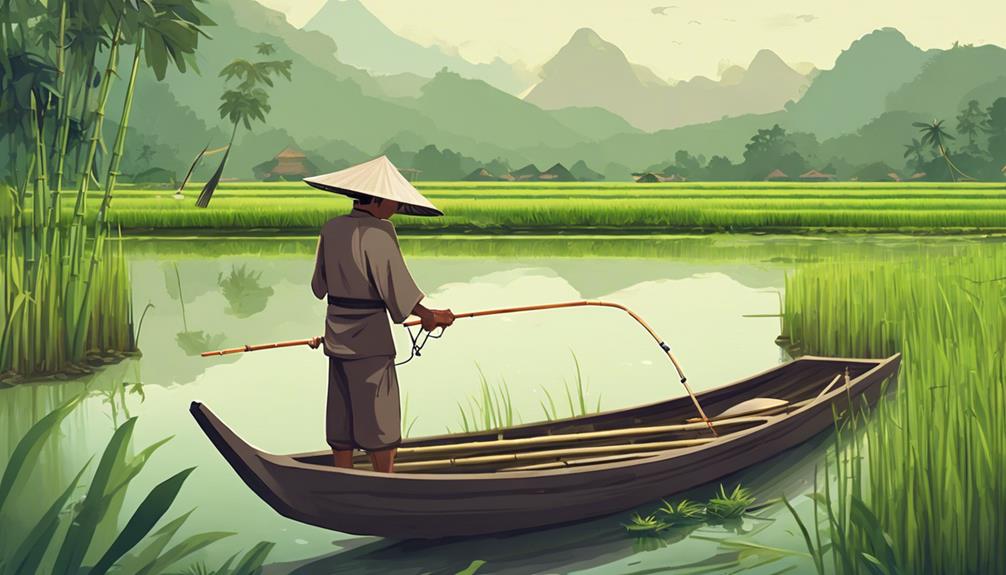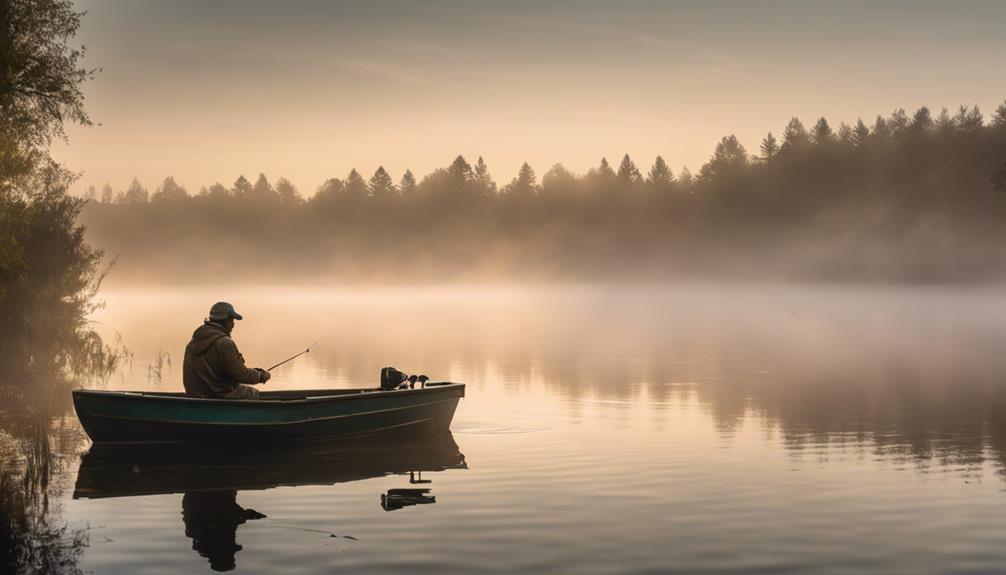Discover ancient Chinese fishing techniques using silk nets and elaborate traps. Explore Japanese fly fishing methods with bamboo rods and precise fly presentation. Learn about traditional Indian angling practices involving eco-friendly gear and spiritual rituals. Uncover unique Korean fishing customs with superstitions and specialized fishing techniques. Dive into Thai traditional fishing methods with ceremonial water spirit honors and bamboo fish traps. These traditions showcase a rich history of angling in Asia, each with its own cultural flair and unique practices waiting to be explored further.
Ancient Chinese Fishing Techniques
Exploring the ancient Chinese fishing techniques reveals a sophisticated system that integrated various methods to catch fish efficiently. The evolution of Chinese fishing practices showcases a deep understanding of the aquatic environment and a mastery of innovative tools and techniques.
Ancient Chinese fishing tools were diverse and purposeful. Nets made from silk or hemp were common, with some dating back to 3000 BC. These nets varied in size and design, allowing for different fishing methods depending on the targeted fish species and the water conditions. Additionally, the Chinese used various traps and weirs to corral fish into designated areas for easier capture.
One of the most significant advancements in ancient Chinese fishing techniques was the development of fish hooks. Initially made from bone or bronze, these hooks evolved over time to become more sophisticated, with intricate designs that increased their effectiveness in catching fish. Chinese anglers also utilized different bait types, such as insects, to attract specific fish species.
Furthermore, the use of fishing boats in ancient China revolutionized the way fish were caught. Early Chinese fishing boats were crafted from bamboo and animal skins, later transitioning to wooden vessels equipped with sails. These boats allowed fishermen to access deeper waters and explore new fishing grounds, expanding their catch potential.
Japanese Fly Fishing Origins
Japanese Fly Fishing Origins trace back to ancient times, revealing a rich history of angling practices intertwined with cultural traditions and meticulous craftsmanship. The origins of Japanese fly fishing can be traced to the techniques used in traditional tenkara fishing. Tenkara, a Japanese method of fly fishing, dates back to at least the 19th century and is characterized by its simplicity and effectiveness.
In Japanese fly fishing, anglers use a long, telescopic rod made of bamboo or carbon fiber, along with a line attached to the tip of the rod. The flies used in this technique are typically simple, with traditional patterns mimicking insects found in Japanese rivers and streams. The key to Japanese fly fishing techniques lies in the precise presentation of the fly, using the rod and line to delicately place the fly on the water's surface.
Japanese anglers have perfected the art of manipulating the fly to mimic the natural movement of insects, enticing fish to strike. This delicate and refined approach to fly fishing showcases the Japanese dedication to craftsmanship and attention to detail. The origins of Japanese fly fishing techniques highlight a deep connection to nature and a harmonious balance between angler and environment.
Traditional Indian Angling Practices
Originating from a diverse cultural tapestry, Traditional Indian Angling Practices exhibit a unique blend of technique, tradition, and reverence for nature. Indian angling innovations have been shaped by centuries of fishing practices, adapting to the country's varied landscapes and ecosystems. Ancient Indian fishing techniques often focused on sustainability, with methods like using herbal bait to attract fish while minimizing environmental impact. Conservation efforts have long been ingrained in Indian angling customs, with communities practicing catch and release to ensure the continued abundance of fish stocks.
One traditional Indian angling method involves using handmade bamboo rods and natural fiber lines, showcasing a deep connection to the environment and a respect for the resources it provides. Innovations such as incorporating eco-friendly materials into fishing gear highlight a modern twist on these ancient practices, demonstrating a continued commitment to sustainability.
Moreover, traditional Indian anglers often integrate spiritual elements into their fishing rituals, viewing the act of fishing as a harmonious interaction between humans and nature. This philosophical approach underscores the deep-rooted cultural significance of angling in India. By blending innovation with tradition and emphasizing conservation efforts, Traditional Indian Angling Practices serve as a testament to the country's rich angling heritage and its commitment to preserving natural resources for future generations.
Korean Fishing Customs and Beliefs
Traditional Korean fishing customs and beliefs are deeply rooted in a rich cultural heritage that intertwines spiritual reverence with practical fishing techniques. Korean fishing superstitions play a significant role in shaping the way fishermen approach their craft. For example, one common belief is that whistling while fishing will scare away the fish, so fishermen avoid whistling to ensure a successful catch. These superstitions are passed down through generations and are still followed by many fishermen today.
In addition to superstitions, traditional fishing rituals are also an essential part of Korean fishing customs. Before heading out to sea, fishermen often perform a ritual called “Gosa,” where they offer prayers for a bountiful catch and safe return. This ritual reflects the deep respect Koreans have for the sea and their acknowledgment of its unpredictable nature.
Moreover, Korean fishermen have developed unique techniques over the centuries to adapt to the diverse marine environments surrounding the Korean peninsula. From using fishing weirs to trap fish in shallow waters to employing specialized nets for deep-sea fishing, Korean fishermen have honed their skills to suit various fishing conditions.
Thai Traditional Fishing Methods
Korean fishing customs and beliefs showcase a deep intertwining of spiritual reverence with practical techniques, setting the stage for exploring Thai traditional fishing methods. Thai fishing rituals and spiritual connections play a significant role in shaping traditional fishing practices in Thailand. Thai fishermen often perform ceremonies to honor the spirits of the water before heading out to fish, believing that this ritual ensures a bountiful catch and safe journey.
Traditional Thai fishing tools and techniques are deeply rooted in the country's rich cultural heritage. One prominent method is the use of bamboo fish traps, known as 'Yor' in Thai, which are strategically placed in rivers and ponds to capture fish. These traps are meticulously crafted by hand and are designed to be efficient yet environmentally friendly.
Another traditional technique involves the use of cast nets, locally known as 'Jaeb' in Thai. This method requires skill and precision as fishermen skillfully throw the net into the water to ensnare fish. The technique has been passed down through generations, with each fisherman adding their unique touch to the practice.
Vietnamese Fishing Techniques Evolution
Vietnamese fishing techniques have undergone a notable evolution over the years, reflecting a blend of cultural heritage and modern advancements in the fishing industry. Traditional netting methods have been a cornerstone of Vietnamese fishing for centuries. These techniques involve the use of various types of nets, such as cast nets, lift nets, and gill nets, which have been passed down through generations. The art of traditional netting not only sustains the livelihoods of many Vietnamese fishermen but also plays a vital role in maintaining sustainable harvesting practices.
In recent years, there's been a shift towards more sustainable fishing practices in Vietnam. With increasing concerns about overfishing and environmental conservation, many fishermen have started adopting more eco-friendly methods. This includes using biodegradable materials for their nets, implementing catch and release practices for certain species, and actively participating in community-driven conservation efforts.
Furthermore, modern technologies have also influenced the evolution of Vietnamese fishing techniques. Innovations such as GPS navigation systems, fish finders, and improved boat designs have enhanced the efficiency and productivity of Vietnamese fishermen. By combining traditional knowledge with modern tools, Vietnamese fishermen are able to navigate the waters more effectively and maximize their catch while still adhering to sustainable harvesting practices.
Angling Traditions in Indonesian Culture

The rich tapestry of Indonesian culture is intricately woven with unique angling traditions that have stood the test of time, showcasing a deep connection to the country's diverse aquatic landscapes. Indonesian fishing rituals are deeply rooted in tradition and are often intertwined with spiritual beliefs. One of the most prominent cultural angling practices in Indonesia is the use of handlines, where fishermen skillfully maneuver a single fishing line with bait attached to catch fish. This traditional method requires precision and patience, reflecting the harmonious relationship between the fishermen and the sea.
Another significant angling tradition in Indonesian culture is the practice of 'Peresean,' a form of ritualistic stick fighting that's accompanied by fishing activities. This ritual, which originates from the Sasak tribe in Lombok, symbolizes the balance between man, nature, and the spiritual world. Participants engage in friendly combat before heading out to sea for a fishing expedition, emphasizing the interconnectedness of physical prowess and the bounty of the ocean.
Furthermore, Indonesian fishing rituals often involve offerings and ceremonies to honor the spirits of the sea. Fishermen seek blessings for a bountiful catch and safe voyages, demonstrating a deep respect for the natural environment and a belief in the spiritual significance of their work. These cultural angling practices not only sustain traditional ways of life but also preserve Indonesia's rich heritage for future generations to appreciate.
Fishing Practices in Malaysian History
Throughout Malaysian history, fishing practices have played a crucial role in shaping the cultural and economic landscape of the nation. Indigenous techniques have been passed down through generations, reflecting the deep cultural significance that fishing holds in Malaysian society. These techniques are often specific to different regions, utilizing knowledge of local fish behavior and habitats.
Historically, Malaysians used a variety of fishing tools that were adapted to suit different environments. Some common historical fishing tools include the 'sudok' (a traditional fishing trap made from bamboo) and 'bubu' (a conical fish trap made from woven rattan). These tools weren't only essential for catching fish but also symbolized the harmony between humans and nature that's deeply rooted in Malaysian culture.
Sustainability practices have also been an integral part of Malaysian fishing traditions. For centuries, Malaysian fishermen have followed principles of sustainable fishing, such as respecting fishing seasons, using non-destructive fishing methods, and avoiding overfishing. These practices have helped preserve the rich biodiversity of Malaysia's waters and ensure the long-term viability of fishing as a livelihood.
Frequently Asked Questions
How Did Environmental Factors Influence Ancient Asian Fishing Techniques?
Environmental factors played a crucial role in shaping ancient Asian fishing techniques. Due to varying ecosystems and resources, you adapted your methods to suit the environment, reflecting a deep understanding of nature.
This environmental adaptation not only ensured survival but also held cultural significance, with fishing practices becoming intertwined with traditions and beliefs.
The ways in which you fished were a reflection of your connection to the natural world and its resources.
What Materials Were Commonly Used in Traditional Korean Fishing Gear?
When it came to traditional Korean fishing gear, nets made from natural fibers like cotton and silk were commonly used. Bamboo rods were also a staple in Korean fishing technology, known for their flexibility and durability.
These historic innovations in Korean fishing gear reflect the ingenuity and resourcefulness of ancient Korean fishermen, who crafted tools suited to their environment and needs.
Were There Any Superstitions Associated With Thai Traditional Fishing Methods?
Superstitions tied closely to Thai traditional fishing methods. Various rituals performed to ensure a bountiful catch. Beliefs in spiritual beings influencing the success of fishing ventures.
Cultural practices involve offerings and ceremonies seeking favor from these supernatural forces. Traditional beliefs shaping the way fishermen approach their craft, blending practical knowledge with spiritual reverence. These superstitions provide a rich tapestry of folklore and tradition in Thai angling practices.
How Did Vietnamese Fishing Techniques Adapt Over Time to Modern Practices?
Vietnamese fishing techniques have evolved significantly, adapting to modern practices through the integration of modern innovations and technological advancements.
Over time, traditional methods gave way to more efficient approaches that leverage tools like sonar technology, motorized boats, and advanced fishing gear.
These adaptations have increased the productivity and precision of Vietnamese fishing practices, enabling fishermen to navigate and exploit marine resources more effectively in today's competitive fishing industry.
What Role Did Religion Play in Shaping Indonesian Angling Traditions?
Religious beliefs in Indonesia have deeply influenced angling traditions. Cultural practices tied to spirituality and reverence for nature have shaped the way fishing is approached in Indonesian communities.
Rituals and ceremonies associated with fishing are often intertwined with religious customs, creating a harmonious relationship between faith and angling practices. This connection between religion and fishing has fostered a unique and sacred approach to angling in Indonesia.
Conclusion
In conclusion, exploring the diverse angling traditions of Asia reveals a rich tapestry of fishing techniques, beliefs, and customs that have been passed down through generations.
From ancient Chinese fishing techniques to traditional Indian angling practices, each culture has its own unique approach to fishing that reflects its history and values.
By understanding these traditions, we gain insight into the deep connection between Asian societies and the natural world around them.



